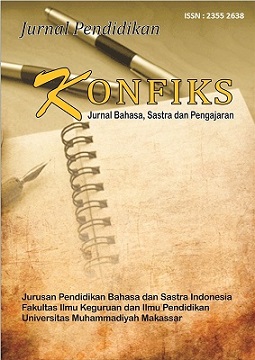DEVELOPMENT OF COMIC LEARNING MEDIA ON STUDENT FABLE TEXTS IN JUNIOR HIGH SCHOOL
DOI: https://doi.org/10.26618/konfiks.v12i2.18302
Development, comics, fable text
Abstract
In the teaching process, educators are expected to take an active role in adapting and delivering diverse teaching strategies. However, a careful examination of the SMP Islam Setia Nurul Azmi classroom reveals persistent challenges in the implementation of effective instructional methods, primarily attributable to the paucity of instructional media available to the teachers. This shortage has a deleterious effect on student motivation. The objective of this study is to develop comic-based educational media focused on fable texts for seventh-grade students, with the aim of enhancing their writing skills. The research methodology employed a Research and Development (R&D) approach based on the 4-D model by Thiagarajan, comprising the following stages: define, design, develop, and disseminate. Data were collected through expert validations and response questionnaires. The media was rated as highly feasible by media experts (90%), content experts (100%), and linguists (86%). A study of usability assessments revealed high practicality scores from teachers (91%) and students (81%). The effectiveness of the assessments was confirmed by an 83% student mastery rate, which is classified as "very effective." Consequently, the comic-based learning media developed through the 4-D model is regarded as highly suitable for utilization as a supportive instructional resource in the classroom.
References
Amalia, R. A., & Bakhtiar, A. M. (2024). Analisis Faktor-Faktor Kesulitan Menulis pada Siswa Kelas Rendah. Jurnal Educatio FKIP UNMA, 10(4), 1373–1381. https://doi.org/10.31949/educatio.v10i4.10755
Anggreini, A., Faridah, Amanda, D. R., Dalimunthe, F. A., & Utami, W. (2024). Analisis Keterampilan Menulis Siswa Melalui Pantun. Jurnal Guruan Inovatif, 6(1), 421–432.
https://journalpedia.com/1/index.php/jpi
Aprilia, P., Yunisa, Anugrah, D., & Awaru, A. O. T. (2023). Peran Guru Dalam Meningkatkan Kemampuan Literasi Membaca dan Menulis. Madani: Jurnal Ilmiah Multidisiplin, 1(11), 548–566. https://doi.org/10.5281/zenodo.10341820
Arsitawati, N. K. S. D., Suharta, I. G. P., & Juniantari, M. (2020). Pengembangan Media Komik Berbasis Guruan Karakter Pada Siswa SMA Kelas X. Jurnal Guruan Dan Pembelajaran Matematika Indonesia, 9(2), 52–61. https://doi.org/10.23887/jppmi.v9i2.1690
Dalman. (2021). Keterampilan Menulis. PT. RajaGrafindo Persada.
Daryanto. (2011). Media Pembelajaran. Media Tutorial Nurani Sejahtera.
Harefa, N. A. J., & Hayati, E. (2022). Media Pembelajaran Bahasa dan Sastra Indonesia dan Teknologi. Unpam Press.
Khaeroni. (2021). Metodologi Penelitian dan Pengembangan. Media Madani.
Kurniawan, H., Sasama, A., & Tambunan, R. W. (2024). Potensi AI dalam Meningkatkan Kreativitas dan Literasi dalam Pembelajaran Bahasa Indonesia. JAMI: Jurnal Ahli Muda Indonesia, 5(1), 10–17.
https://doi.org/10.46510/jami.v5i1.285
Marinda, L. (2020). Teori Perkembangan Kognitif Jean Piaget Dan Problematikanya Pada Anak Usia Sekolah Dasar. An-Nisa’: Jurnal Kajian Perempuan& Keislaman, 13(1), 116–152.
https://doi.org/10.35719/annisa.v13i1.26
Munirah. (2020). Pengembangan Keterampilan Menulis Paragraf. Unismuh.
Salsabila, N. A., & Rasyid, H. Al. (2023). Pengembangan Media Pembelajaran Komik Bahasa Arab Berbasis Canva. Journal of Education Research, 4(2), 484–495. https://doi.org/10.37985/jer.v4i2.182
Saputro, H. B., & Soeharto. (2015). Pengembangan Media Komik Berbasis Guruan Karakter Pada Pembelajaran Tematik-Integratif Kelas IV SD. Jurnal Prima Edukasia, 3(1), 61–72. https://pdfs.semanticscholar.org/8552/3cac9f69808ed108716073e5a1387235c5ac.pdf
Sari, N. P., Salminawati, & Nurkholidah, R. (2023). Pengaruh Media Gambar Tunggal Terhadap Keterampilan Menulis Paragraf Deskripsi Siswa Kelas V MIN 11 Kota Medan. JUPENDIS: Jurnal Guruan Dan Ilmu Sosial, 1(4), 238–251. https://doi.org/10.54066/jupendis.v1i4.929
Soedarso, N. (2015). Komik: Karya Sastra Bergambar. Humaniora, 6(4), 496–506. https://doi.org/10.21512/humaniora.v6i4.3378
Sugiyono. (2020). Metode Pengembangan Kuantitatif Kualitatif dan R&D. Alfabeta.
Telaumbanua, A., & Harefa, N. A. J. (2023). Pengembangan Media Pembelajaran Bahasa Indonesia dalam Bentuk Komik pada Materi Menelaah Struktur dan Kebahasaan Fabel. Ta’ehao: Jurnal Ilmiah Guruan Bahasa Dan Sastra Indonesia, 2(1), 142–151. https://doi.org/10.56207/ta’ehao.v1i1.xx
Winaryati, E., Munsarif, M., Mardiana, & Suwahono. (2021). Cercular Model of RD&D (Model RD&D Guruan dan Sosial). Penerbit Kbm Indonesia.
Yusup, P. M., Rachmawati, T. S., Damayani, N. A., & Rukmana, E. N. (2020). Koleksi Buku Cerita Bergambar (Picture Storybooks) Di Perpustakaan Desa Sukamukti. Berkala Ilmu Perpustakaan Dan Informasi, 16(1), 83–96. https://doi.org/10.22146/bip.v16i1.151
Zalukhu, F. F., Zega, E. V. A. N., Daeli, F. F. D., & Bawamenewi, A. (2023). Pengembangan Media Gambar untuk Meningkatan Kemampuan Menulis Teks Eksplanasi dengan Penerapan Model Project Based Learning. Journal on Education, 06(01), 5793–5800.
http://jonedu.org/index.php/joe
Zega, R. R., & Bawamenewi, A. (2023). Pengembangan Media Komik Digital Berbasis Flipbook Pada Mata Pelajaran Bahasa Indonesia Di Sekolah Menengah Pertama (SMP). Primary Education Journals, 3(2).
Downloads
Published
Issue
Section
License
Authors who publish with this journal agree to the following terms:
The author owns the copyright and grants the journal rights for first publication with the work simultaneously licensed under a Creative Commons Attribution License which allows others to share the work with acknowledgment of the work's authorship and initial publication in this journal.
Authors may enter into separate additional contractual agreements for the non-exclusive distribution of the published journal version of the work (for example, posting it to an institutional repository or publishing it in a book), with acknowledgment of its initial publication in this journal.
Authors are permitted and encouraged to post their work online (for example, in institutional repositories or on their websites) before and during the submission process, as this can lead to productive exchanges, as well as earlier and larger citations of published work (See The Effect of Open Access).
Statement of Authenticity and Manuscript Copyright can be downloaded: Here
After filling in the statement letter, please send via e-mail: konfiks@unismuh.ac.id





.png)


